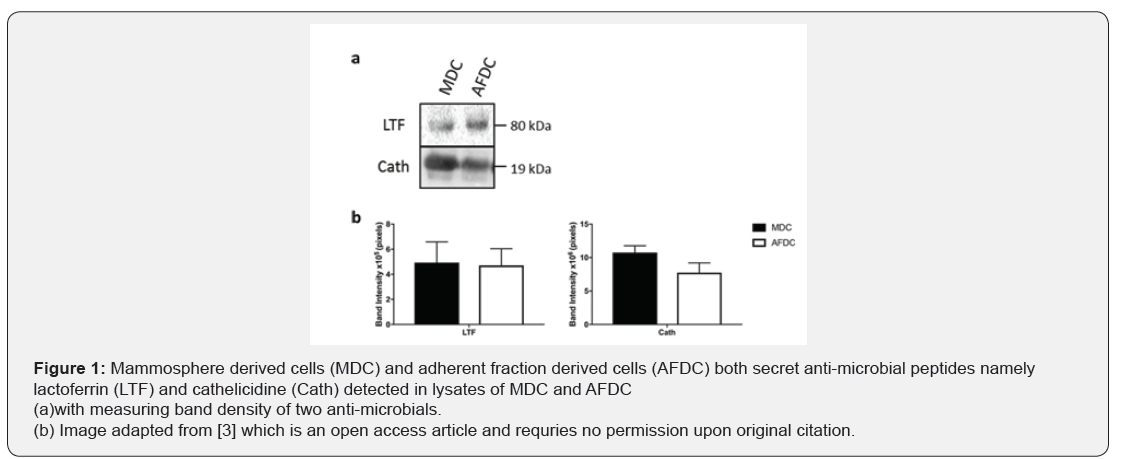Secrets of Mammary Stem Cells Secretome- Juniper Publishers
Journal of Dairy & Veterinary Sciences- Juniper Publishers
Abstract
The role of mammary stem/progenitor cells and its
secreted proteins in therapeutic application has not been evaluated
yet. Here, author reviewed information pertaining to secreted proteins
of mammary epithelial cells and mammary stem/progenitor cells and
supported their ideas that secretome could potentially be explored for
natural antimicrobials against supportive therapy of bovine mastitis.
Keywords: Mammary stem
cell; Secretome; Mastitis; Bovine; Spectrophometer; Proteins;
Laboratory; Lactoferrin; Receptors; Biomarkers; Pacific; Population;
Antibiotics; Progenitor cellsAbbrevations: HMEC: Human Mammary Epithelial Cells; CM: Conditioned Medium; EGFR: Epidermal Growth Factor Receptor; AFDC: Adherent Fraction Derived Cells; MDC: Mammosphere Derived Cells; TGFβ: Transforming Growth Factor Beta; MDBK: Madin Darby Bovine Kidney Epithelial; LPS: Lipopolysaccharides
Opinion
Secretome are the cell secreted proteins released in
the cell extracellular space. Groups of proteins present in the
secretome are involved in signalling and cell communications. Study of
such proteins, thus would be helpful in understanding the niche of the
cell. Researchers of Pacific Northwest National Laboratory, Washington
probably was the first group which demonstrated secretome of human
mammary epithelial cells (HMEC) in 2008 [1]. They identified secretome
of human mammary epithelial cells (HMEC)-conditioned medium (CM) cell
lysates and showed regulation of matrix metalloproteases through
epidermal growth factor receptor (EGFR). In 2009, Simpson and
co-investigators have profiled three different secretome of basal MaSC,
luminal progenitors and mature luminal cell lines. In this study, in
addition to enriched expression of ephrin receptors and integrins, the
activity of Wnt signalling pathway was uniquely detected in the MaSC
[2]. In a recent publication of Scientific Reports journal, researchers
from Cornell University, Ithaca, NY has defined secretome of mammosphere
derived MaSC and opened up new doors for the possible treatment of
bovine mammary gland infections [3].
For their studies, the team isolated cultured two
different populations of bovine mammary cells- adherent fraction-
derived cells (AFDC) and suspension mammosphere-derived cells (MDC).
These two cell population were immunopheno typically different as
analyzed by various cell surface markers. However, the expression of
CD44 and CD49f was higher in MDC
CM than the AFDC CM. Level of CD29 was high in CM of both these cells.
Proteome analyses of AFDC and MDC CM, using mass spectrophometer,
revealed 347 and 537 matched proteins and peptides functionally related
to defense and immunity and tissue regeneration like angiogenesis and
cell migration. Furthermore, two antimicrobial proteins namely
lactoferrin and cathelicidine have been validated and quantified using
Western blot (Figure 1) and observed differential expression of the
proteins in CM of MDC versus AFDC. Two angiogenesis factors namely,
angiopoetin 1 and vascular endothelial growth factor alpha, angiopoetin 1
showed high expression level in MDC CM. Likewise, levels of proteins
involved in cell migration (transforming growth factor beta (TGFβ),
Insulin-like growth factor-1 and hepatocyte growth factor) were
estimated in the CM and found that the concentration of TGFβ was high in
CM of MDC. TGFβ induces epithelial cell to mesenchymal type and
promotes cell migration. Taken together, this study showed CM of AFDC
and MDC contains various proteins which have roles in tissue
regeneration and immune defence of the host.

Interestingly, proteins of AFMC and MDC also contained
factors which protects bacterial toxin-induced MEC death.
Loss of MEC damage is an important consequence of mastitis
and it is induced by the toxins of Gram-positive bacteria
and lipopolysaccharides (LPS) of Gram-negative bacteria. A
significant reduction in growth of bacteria (measured by optical
density) was observed when Madin-Darby Bovine Kidney
Epithelial (MDBK) cells were grown in presence of Klebsiella (a
Gram-negative bacteria) and Staphylococcus aureus (a Grampositive
bacteria) in presence of MDC CM. The researchers also
evaluated shelf-life of MDC CM for one week and found that
frozen CM is biologically effective on MDBK cell migration. The
storing of CM for long time would be advantageous for future
clinical use in mastitis management even at remote places.
In summary, these studies providing rationale for the
potential use of MDC secretome as supportive or adjunct therapy
in bovine mastitis. Secretome could be an ideal biological
source for naturally occurring anti-microbial and potentially
beallogenically safe like antibiotics. In future, an important
follow-on studies should include evaluation of novel proteins as
biomarkers and identification of newly identified proteins with
no to little annotations. In vivo application of MDC secretome
in management of naturally occurring bovine mastitis, also
warranted future investigations.
To know more about journal of veterinary science impact factor: https://juniperpublishers.com/jdvs/index.php
To know more about Open Access journals Publishers: Juniper Publishers




Comments
Post a Comment